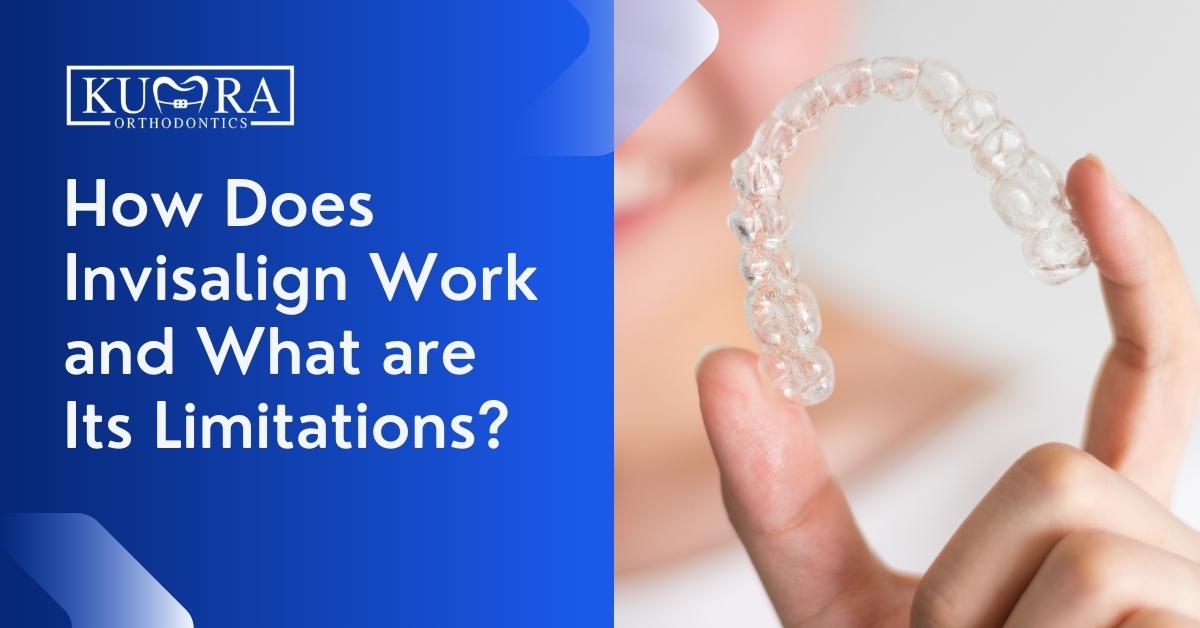Invisalign aligners have become a popular alternative to traditional braces for adults and adolescents. Individuals who have crooked or gapped teeth can benefit from this procedure. But how does Invisalign work? In this article, we’ll explore how it works and what it cannot accomplish.
What is Invisalign?
Invisalign is a clear, plastic aligner that fits the teeth like retainers and gradually straightens them throughout treatment.
The clear aligners are comprised of a flexible plastic material called SmartTrack® that was developed specifically for Invisalign treatment. The trays’ transparent section is made of BPA-free plastic. And indeed, the material is relatively translucent, making it difficult to tell you’re wearing them! This is one of the reasons why many adults and teenagers prefer Invisalign over traditional braces.
Trays are also custom-made based on a three-dimensional representation of your entire mouth. This means that the aligners will cause the teeth to shift into their proper place.
As the teeth move into the ideal position, your dental care specialist will create new aligners to maintain them progressing gently. It’s a procedure free of the constraints associated with metal braces.
Because Invisalign moves your teeth collectively rather than individually, it typically results in a straighter smile faster than traditional metal braces.
Needing an orthodontic appointment?
Visit Kumra Orthodontics Washington, DC or Kumra Orthodontics Stafford, VA, and request an appointment with us!
How does Invisalign work?
To plan the aligners, the orthodontist will use a digital model of your teeth to produce a 3D computer model. Your orthodontist can figure out where your teeth should be moved using this information. In phases, each misplaced tooth shifts. Depending on your unique circumstance, your treatment may require up to 48 aligners. However, this varies from person to person and impacts how long it takes for the aligners to work for you.
Before installing the next aligner, your teeth will have moved by up to.33 millimeters with each of the aligners you’ve worn. As a general rule, you can expect to switch out your aligners around once every two weeks.
Invisalign gently forces the teeth into place, similar to metal braces. Aligners help to move teeth into the proper position. It is not unpleasant, although there is some discomfort. However, do not be alarmed. This is completely normal and indicates that your aligners are working.
However, you must wear the aligners for a minimum of 20 hours per day. However, the ability to remove the trays is a better deal than what conventional braces offer.
Additionally, treatment with Invisalign is often less time-consuming than conventional orthodontic treatments.
Invisalign treatment often takes six months less than traditional braces.
Naturally, this is contingent upon the severity of your teeth and bite. Recovery time for minor dental defects is typically between six and twelve months. Your orthodontist may require you to wear the trays for up to 18 months if you have a more complex orthodontic problem that requires more time to correct.
Patient compliance with their aligners also affects the duration of treatment. This is why aligners should be worn daily for at least 20 hours to be effective.
When eating and brushing your teeth, remember to take them out. Otherwise, you should be ready to wear your aligners regularly. Because if you wait too long for the aligners to do their job, you may not get the desired results as quickly.
Initially, your teeth and jaws may feel a little sore from wearing the aligners for the first time. Normal and mild reactions are usual. To begin with, wearing plastic trays will be uncomfortable, and it will be tempting to remove the aligner from your teeth. However, you must not. Dedicate the necessary time each day to wearing your trays. Wearing the aligners becomes second nature after a few days of discomfort.
Related: How to Easily Remove Invisalign in 6 Ways
Invisalign Limitations
While Invisalign can correct various bite abnormalities, it does not always perform well as traditional braces. Many of our patients are curious about what Invisalign cannot correct. The following are some scenarios in which people have difficulties with Invisalign:
Severe cases: While a mild overbite can be corrected, a severe overbite may require braces.
Tooth form: Too short or crooked teeth can make Invisalign ineffective.
Position of the teeth: If your teeth are excessively rotated, Invisalign will be unable to realign them.
Large chasms: While Invisalign can close minor gaps between teeth, larger gaps may necessitate braces. Intrusion and extrusion are two terms that refer to the same thing. Invisalign cannot be used to straighten or straighten teeth.
Dental work performed previously: Patients who have had dental work like bridges may not be eligible for Invisalign.
Patients who have decayed teeth or gum disease: Braces and aligners such as Invisalign can make dental hygiene more difficult, and if patients require cavity filling during treatment, the fit of the clear aligners may be compromised, compromising their results.
Read More: Can Invisalign Fix a Crossbite?
Contact Kumra Orthodontics to learn more about how does Invisalign work
Since Invisalign was brought to the market, it has been credited with over 3 million joyful smiles, and the number continues to climb. Due to its ease of use, Invisalign is the preferred teeth straightening method for most patients. It has little or no effect on daily living, and the treatment time is virtually painless. As a Washington Invisalign orthodontist, we can assist you in achieving the smile of your dreams.



